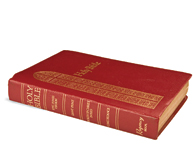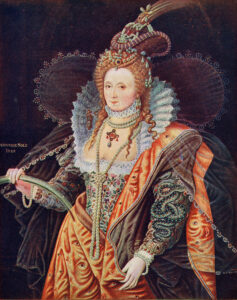 In the years following Henry’s death, the country rocked violently from Protestant Edward VI’s rule to Catholic Queen Mary’s reign (John Rogers was just one Protestant to be burned at Smithfield), to the more tolerant Elizabeth I. In 1560 English Calvinist exiles in Geneva published the Geneva Bible, complete with contentious notes that also questioned unconstrained royal power—the Puritans loved it, the royal establishment less so. In 1568, the English Church then commissioned its own (more “royalist” and anti-Puritan) tome, which became known as the Bishops’ Bible. English Catholics abroad followed up with the Rheims-Douai Bible.
In the years following Henry’s death, the country rocked violently from Protestant Edward VI’s rule to Catholic Queen Mary’s reign (John Rogers was just one Protestant to be burned at Smithfield), to the more tolerant Elizabeth I. In 1560 English Calvinist exiles in Geneva published the Geneva Bible, complete with contentious notes that also questioned unconstrained royal power—the Puritans loved it, the royal establishment less so. In 1568, the English Church then commissioned its own (more “royalist” and anti-Puritan) tome, which became known as the Bishops’ Bible. English Catholics abroad followed up with the Rheims-Douai Bible.
The translating committee of this new Bible was to be split
And now, in 1603, along came Protestant James Stuart from Scotland to be England’s sovereign. Puritan reformists were quick to petition the new king to rid the Church of all remaining vestiges of Papist practices—essentially, to “complete” the Reformation in England. The bishops, representing the status quo of the Anglican hierarchy, also had a word in the royal ear, urging James to stand firm on their behalf.
In fact, James was no lover of Puritanism, and he certainly believed in the divine right of kings. He disliked violent factionalism—his reign in Scotland since 1567 had been troubled by the need to appease strong Presbyterian currents. So he agreed to hold a conference at Hampton Court Palace, in January 1604, at which Puritan representatives and the bishops could air their grievances.
It was a pretty sour meeting, at which the King essentially came down on the side of the bishops, including a rejection of Puritan requests for the Geneva Bible to be adopted as the standard text across England. He did, however, sanction the commission of a new “uniform translation…and this to be done by the best learned of both the Universities, after them to be reviewed by the Bishops, and the chief learned of the Church; from them to be presented to the Privy Councell; and lastly to be ratified by his Royall authority; to be read in the whole Church, and no other.”
The Puritans were underwhelmed.
The translating committee of this new Bible was to be split into two Westminster Companies, two Cambridge Companies and two Oxford Companies. Each of these six groups would have a director and eight further Translators (referred to at the time with a capital “T”). The final numbers varied slightly, but each company was responsible for different sections of the Bible. Translators worked individually on passages first, then took their labors to a weekly meeting of their company to compare with each other’s efforts, discuss and fine tune. And all that before each company’s drafts were circulated for peer scrutiny. Little wonder it would take seven years.
So who were the Translators? While the idea was to be inclusive, all the checks and balances in place to review the end work make it clear that nothing too contentious would be allowed. Cambridge, let it be remembered, was a seedbed of English Puritanism; Oxford, though notorious earlier on for housing Lollard followers of Wycliffe, was now the more orthodox and traditional of the two universities. Many of the London lot were alumni or connected with Oxbridge. A few of the otherwise forgotten names involved gives a flavor:
Lancelot Andrewes, Cambridge educated, brilliant and politically astute was director of The First Westminster Company that met in the Jerusalem Chamber of the Abbey. His career embraced persecution of Separatists and the acquisition of plum posts like dean of Westminster. There were no Puritans in The First Westminster Company, rather folks like racy Richard Thomson, the witty translator of Martial, and John Layfield, a Greek scholar from Trinity, Cambridge, who was also an explorer and travel writer (witness his generous account of the English arrival in the New World).
Charismatic, Lancashire-born Laurence Chaderton, Translator in The First Cambridge Company, had been part of a radical Puritan movement in the 1580s and became first master of Emmanuel College. William Branthwaite, a safe government candidate and founding fellow of Emmanuel College under Chaderton, was put into The Second Cambridge Company to replace a man suspected of Catholicism.
John Rainolds (or Reynolds), an anti-theater, anti-bishop type, was president of Corpus Christi, Oxford, and The First Oxford Company met in his rooms. George Abbot of The Second Oxford Company would help to reestablish bishops in Scotland and became Archbishop of Canterbury in 1611. Sir Henry Savile, in whose rooms the company met, had tutored Elizabeth I in Greek and became warden of Merton College, Oxford, and provost of Eton.
To these, several dozen learned scholars and colorful characters could be added, though infuriatingly little is known of the details of their meetings. Andrewes at one time claimed of his Westminster colleagues, “Most of our company are negligent,” and Rainolds held meetings “all the while sorely afflicted with gout.”
A manuscript of the Bishops’ Bible found in Oxford’s Bodleian Library gives a more intimate glimpse of the translating process: it had been ruled that the Translators should take the Bishops’ Bible as their start point, and here is shown the first suggestions and changes made by one individual that he would have taken to his weekly meetings.
The Translators aimed for accuracy and that also included literal renditions rather than paraphrases of the original languages of the Bible: hence “skin of my teeth” and so on was introduced to a new audience. Ancient Hebrew and Greek words with no English equivalent (parable, apostle) also enriched the text and, ironically, a new lease of life was given to word forms that had been fading: “thee” and “thou,” or verbs ending in “-eth” (“sayeth” not “says”), for example. The overall effect is one of poetic intensity and words freighted with meaning (though curiously the scholars transformed the poetry of, say, Psalms into prose). Moreover, the Translators read aloud to each other, encouraging a sonority and musicality in their handiwork.
There is no doubt that the efforts of those who went before, in particular Tyndale, influenced the KJV, but the latter combines and surpasses them in luscious literary terms. Some folk will always prefer the straight-talking, accessible prose of more modern Bible versions; others hear in the KJV not simply antique expressions, but the richer sounds of something extraordinary, a hallowed eternal mystery.
And yet the King James Bible was ill received when it first appeared in 1611, not helped by countless printing errors—which persisted most memorably (yet without boosting popularity) in the exhortation of the 1631 print run, the so-called Wicked Bible, “Thou shalt commit adultery.” Even the Translators had quoted from the Geneva Bible in the introduction to the KJV, and it was this earlier tome, despite a royal ban on printing it in England, that generally prevailed.
But in the long run, after further religious shake-down between Anglican Church and Puritanism, the swash and buckle of civil war, of Royalist against Roundhead, public appetite for the KJV grew: maybe whetted also by a feeling that it came from an era whose colors were preferable to the gray days of Oliver Cromwell’s republic. The King James Bible became a roaring success and would travel around the world with English colonists; its Translators were largely forgotten, but the life and immediacy of their work lived on. Miles Smith (a Corpus Christi and Brasenose man) wrote in the Preface to the KJV:
“Translation it is that openeth the window, to let in the light, that breaketh the shell, that we may eat the kernel; that putteth aside the curtain, that we may look into the most Holy place; that removeth the cover of the well, that we may come by the water.”



